India > Forts & Monuments > Central & Western India - Madhya Pradesh
MADHYA PRADESH
Jahaz Mahal
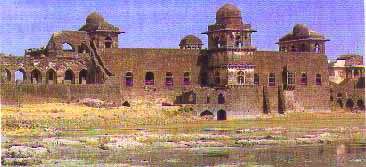
Jahaz Mahal or the ship palace was built by Sultan Ghiyas-ud-din-Khilji to maintain his large Harem (place where the ladies of rulers lived). This palace is in shape of a ship and is locate between Munj Talao and Kapur Talao (pond). The balconies hanging over the water and the open terraces appears as a royal pleasure craft. In fact hidden motif of building this palace might have been to carve out a pleasure ship from stone. In the moon light the sight of this structure as viewed from Taveli Mahal is unforgettable. The spectacular silhouette of the domes and turrets perched on terrace is sight to cherish life long. Jahaz Mahal is a double storied structure which is which represents the grace of royalty which decorated this place in the past. This palace is 120 meter long and 15 meter wide.
Sanchi Stupa

Sanchi is famous for its stupas, monasteries, temples and pillars dating from the 3rd century BC to the 12th century AD. The Sanchi Stupa, the best known of all, was originally built by the Mauryan Emperor Ashoka, then Governor of Ujjayini, whose wife Devi was the daughter of a merchant from the adjacent Vidisha. Their son Mahindra and daughter Sangamitra were born in Ujjayini and sent to Sri Lanka, where they converted the king, the queen and their people to Buddhism. A chunar sandstone pillar fragment, shining with the proverbial Mauryan polish, lies near Stupa 1 and carries the famous edict of Ashoka's warning against Buddhism in the Buddhist community. Stupa 1 was found empty, while the relics of the two disciples of Buddha enshrined in the adjacent Stupa 3 were carried away to England. The nearby modern Buddhist temple has a reliquary containing the remains of Buddhist teachers from another Stupa outside Sanchi.
The balustrade surrounding Stupa 2 was added in the late 2nd century BC under the Sungas, while the four gateways of Stupa 1 were built in the 1st century BC, under the Satyavahanas. Carved with stories of Buddha's past and present, and incidents from Buddhist history, the gateways are the finest specimens of early classical art.
Located approx. at 46 km from Bhopal Airport, and the most convenient railhead in Vidisha (10 km), is also well connected by motorable roads. State Tourism's Boarding and Lodging is easily available.
Four Gate Ways, Sanchi
The Four gateways constructed in 35 BC are the best from of Buddhist expression one can find any where in the world. Gateways or Torans as they are called are covered with explicit carving which depict scenes from the life Buddha and the the Jatakas, the stories relating to Buddha and his earlier births. At this stage Buddha was not represented directly but symbols were used to portray him - the lotus represents his birth, the tree his enlightenment, the wheel, derived from the title of his first sermon, the footprints and throw symbolizing his presence. The carvings on the Torans are done with inspired imagery which in harmony with the surrounding figures balance the solidity of massive stupas.
The Western Gate : This gate has depictions of the seven incarnations of Buddha. The six incarnations before becoming the Buddha is called the Manushi Buddha. The architraves is supported by the dwarfs. One of the pillars shows Buddha resisting the temptation of Mara. While the demons are fleeing the angles cheer Buddha. On the bottom architraves the colourful stories of the Chhadanta Jataka are also carved with the intense care. Pot bellied dwarfs support the architraves on this gate.
The Eastern Gate : The pillars of this gate depicts story of the great departure of Prince Gautama. The pillar shows vividly the moments when the Gautama was leaving his fathers a place in search of Enlightenment. It also depicts the dream which Gautama's mother had before his birth. On the pillar Buddha is shown as riderless horse. Also on the architraves are hanging images of Yakshi which is one of the best known images from Sanchi.
The Southern Gate : This gate is a representation of scenes from the life of Ashoka and Buddha's birth. There is another representation of the Great departure. This oldest of the three gates and is very rich in the carvings.
The Northern Gate : This gate is crowned by the wheel of law and depicts the miracles which took place during the life of Buddha. Though the wheel is broken the northern gate is the most well preserved gates of all the four. The architraves of this gate is supported by elephants facing four directions, the gap between the architraves is filled by more horses and elephants.
Raj Mahal
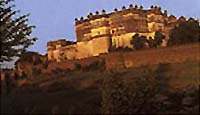
Situated to the right of the quadrangle, this palace was built by Madhukar Shah, the deeply religious predecessor of Bir Singh Ju Deo. The plain exteriors, crowned by chhatries, give way to interiors with exquisite murals, boldly colourful, on a variety of religious themes. All types of accommodation are available.
Orchha located at a distance of 119 km from Gwalior Airport and 16 km from Jhansi Railway Station, while regular road transports connect Orchha with Jhansi. Hotels catering all budgets are available.
Barua Sagar
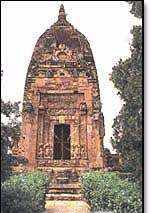
Barua Sagar is situated on the banks of the Betwa river. The place is named after the Barua Sagar Tal, a large lake created about 260 years ago when Raja Udit Singh of Orchha built the embankment. Here, atop a hill, is another of the historic forts of Bundelkhand. This is where the Marathas fought the Bundelas in 1744. the view from the fort is magnificient, as it overlooks the vast resource created by the dam across the Betwa. The sandstone fort, partially in ruins, is currently being restored by the Archaeological Survey of India.
Barua Sagar is also known for a beautiful temple, the Jarai-ka-Math. Built during the reign of the Pratiharas, it is a repercussion to the vigorous temple-building activity which became a characteristic feature of the Chandellas. The temple is dedicated to Devi (Amba or Durga) whose multifarious forms are represented in the profusely carved sculptures along the temple walls. The temple stands on elevated ground dominating its surroundings. The main image of the deity is missing from the sanctum sanctorium. Only the pedestal, and the jeweled right foot of a female placed on a lotus stalk, remains. This detail is traditionally associated with the goddess Tara or Mateswari. The placement of a miniature, sixteen-armed image of a goddess on the central lintel of the entrance further supports the conjecture that the temple is dedicated to a goddess. Erotic sculptures, akin to those at Khajuraho, also grace the Jarai-ka-Math.
Dated to approximately 860 AD, this red sandstone temple is a pancharata shrine of the Panchayatan type, in which the main temple is surrounded by four subsidiary shrines at the four corners. Declared a protected monument by the Archaeological Survey of India in 1928, the temple is an excellent example of early Pratihara architecture.
Barua Sagar is pleasant place, and its vast water body greatly enhances its appeal.
Jai Vilas Palace
Built in 1809, this palace is located in the new city of Gwalior. It the house of the present Maharaja of Gwalior. This palace was designed by Lt. Col. Sir Michael Filose. 35 of the rooms have been converted into the Scindia Museum and the rest of the rooms reflect the splendour and glory which comes alive in the Italianate structures. The Tuscan and Corinthian architectural modes are combined in Jai Vilas. The Darbar hall of the palace is an imposing structure. Covered with heavy draperies and tapestries, fine Persian carpets and furniture from Italy and France occupy these spacious rooms. The darbar hall ceiling has two incredibly massive chandeliers weighing in tonnes. The treasure of the palace includes a silver train which has cut glass wagons carrying wine and cigars after dinner, a glass cradle used for Lord Krishna on every Janamashtami, swords once worn by Aurangzeb and Shah Jehan. Apart from these there are personal gifts and mementoes of Scindia Family which includes the Jewelled slippers of Chinkoo Rani, hunting trophies and portraits, also small room having collection of erotica. Jai Vilas is an excellent glimpse into the rich culture and lifestyle of princely India.
Shivpuri, Gwalior
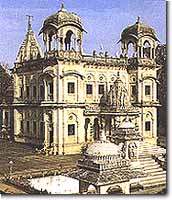
Shivpuri was the summer capital of the Scindia and is 122 km on the Mumbai- Agra highway. Shivpuri has numerous palaces and lakes which reminds of the splendour this place must have seen during the reign of Scindias. The delicate filigree and the inlaid marble work are unique and exquisite on the fabled chhatris of Shivpuri. These chhatris are the memorials of the Scindias. The monuments of Shivpuri have a combination of Hindu and Islamic architectural types. Shivpuri also has a national park better known as the Madhav national park. Driving through the park is an enthralling experience and one can see a variety of rare avian species. The park is open through the year and accommodation is provided by the Madhya Pradesh Tourism run Tourist village.
Asharfi Mahal, Mandu
This was essentially build as Madrassa, a place for Islamic teaching. Even today the rooms and cells tell a story of teaching and studying. The name means palace of gold and was build by Mahmud Shah Khilji. The Ashrafi Mahal faces the Jami Masjid. In the same complex are few others structures. There is a tower which was seven storied high when built. This tower was built to celebrate the victory of Mahmud Shah Khilji over Rana Khumba of Mewar. Sadly out of the seven stories only one survives today. In the same premises are ruins of tomb which was intended to be largest structure of Mandu. But the structure collapsed due to faulty construction and bad planning. When compared with other structures Ashrafi Mahal is in very good shape of preservation
Hindola Mahal, Mandu
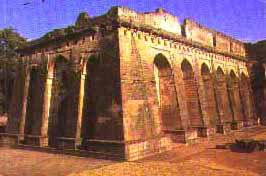
The church like Hindola mahal or the Swinging palace derives its name from the sloping sidewalks. Due to the slopes the walls of this palace seems to be swinging. Hindola mahal essentially was a meeting place during Ghiyas-ud-din-Khilji's time. The architecture of this building is unique and very innovative. Probably the clopes were built to take the rulers upstairs on elephant. The decorated facades and delicate trellis on the moulded coloumns add to the beauty of this sandstone structure. On the western side of this structure there are many building and structures which narrate a saga of past grandeur and glory. One interesting structure is the Champ Baoli or pond which has a underground arrangement of vaulted rooms for hot and cold water. Close to Hindola palace are Dilawar Khan's Mosque, Nahar Jharokha, Taveli Mahal, two wells called Ujali and Andheri Baoli (pond), Gada Shah shop and house. All these places are worth giving a look.
Gwalior Fort
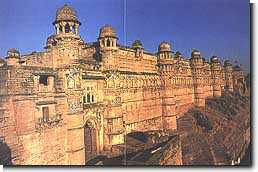
For over 100 years this fort has been over looking the city of Gwalior. One of the most invincible forts in India, this imposing citadel has changed many hands. It is build on a hill of sandstone and towers 100 m from the plain. The outer wall of the fort is almost 2 miles in length and the width varies from one kms to 200 meters. The walls of the fort gives way onto the steep slopes. This fort has been a witness to many battles in the turbulent times as well as as festivals in the peace time. The rulers have imparted justice from the fort which has seen the imprisonment of many. The ceremonies held in the fort have been spelled out grandeur but the Jauhars have screamed distress. It was here that Tatyia tope and Rani of Jhansi fought for their freedom. Rani of Jhansi laid down her life in an assault by the British to capture the fort.
The structure, the placement, the architecture, every thing of the fort is unparalleled. Babur after seeing this fort had said that this is the pearl of forts in India. The fort can be accessed by a winding path which takes you up hill and is flanked by statues of Jain Tirthankars carved into the rock faces. Within its walls this citadel treasures numerous marvels of medieval architecture - palaces, temples and other structures many of which are in ruins but some are in excellent shape. On a clear day from the walls of the fort one can have a birds eye view of the city. The fort has changed hands from the Tomars to the Mughals to the Marathas to the British.
In the 14th century Tomars came to power in Gwalior and made the fort their seat of administration. For the next few centuries the fort was witness to numerous conflicts with the neighbouring states. The greatest Tomar King Raja Man Singh in a bid to win over the Gujar princes Mrignayani built the Gujari Mahal in the 15th century. This palace has survived the time and the interior of the mahal has been converted into an archaeological museum. The Man Mandir Palace was also built by Raja Man Singh. The tiles that adorned the exteriors of the palace have not survived but the traces of its beauty still remains. Rooms of the palace stand bare today presenting a moot testimony to the past glory which was lost with the passage of time. The intricate decorations in the rooms and the filigree work on the stone screens were once part of the music halls. Behind these screens the Royal ladies sat down and took lessons of music from the masters of those times.
Below the palace are the dungeons were the prisoners spent their imprisonment. Aurangzeb imprisoned his brother Murad here and later executed him. Near the Man Mandir is the palace were the ladies performed Jauhar after the defeat of their husbands in war. The Teli ka Mandir dates back to the 9th century. The roof of this structure is made in the Dravidian style but the decorations on walls is done in the Indo Aryan style. This strange combination of two architectural styles has been the main attraction for the visitors. The highest structure within the fort is the Garuda. Dedicated to the Pratihara Vishnu, the structure a blend of Muslim and Indian architecture. The oldest structure which survives today is the Sas Bahu ka Mandir which was constructed in 11th century by Kachchwah king, Mahipala.
The poignant ambience of chivalry and heroism has been recreated through the superbly mounted Son-et-lumiere. The light and sound show recreates the glorious days. Narrated by the famous film actor Amitabh Bacchan. Assisted by the bright lights and digital sound, the saga of heroism, valour and romance floats in air every evening.

